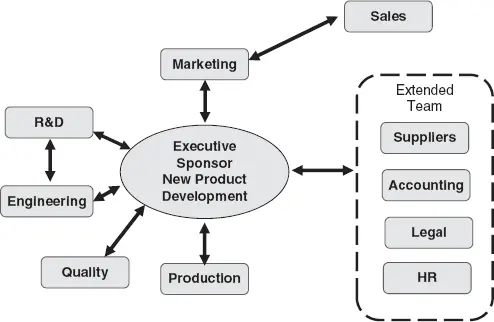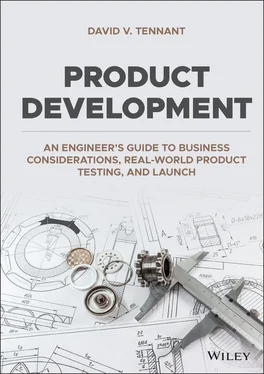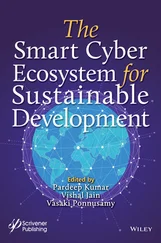David V. Tennant - Product Development
Здесь есть возможность читать онлайн «David V. Tennant - Product Development» — ознакомительный отрывок электронной книги совершенно бесплатно, а после прочтения отрывка купить полную версию. В некоторых случаях можно слушать аудио, скачать через торрент в формате fb2 и присутствует краткое содержание. Жанр: unrecognised, на английском языке. Описание произведения, (предисловие) а так же отзывы посетителей доступны на портале библиотеки ЛибКат.
- Название:Product Development
- Автор:
- Жанр:
- Год:неизвестен
- ISBN:нет данных
- Рейтинг книги:5 / 5. Голосов: 1
-
Избранное:Добавить в избранное
- Отзывы:
-
Ваша оценка:
- 100
- 1
- 2
- 3
- 4
- 5
Product Development: краткое содержание, описание и аннотация
Предлагаем к чтению аннотацию, описание, краткое содержание или предисловие (зависит от того, что написал сам автор книги «Product Development»). Если вы не нашли необходимую информацию о книге — напишите в комментариях, мы постараемся отыскать её.
An insightful development roadmap to help engineers and businesspeople successfully bring a product to market Product Development: An Engineer’s Guide to Business Considerations, Real-World Product Testing, and Launch,
Product Development
Product Development
Product Development — читать онлайн ознакомительный отрывок
Ниже представлен текст книги, разбитый по страницам. Система сохранения места последней прочитанной страницы, позволяет с удобством читать онлайн бесплатно книгу «Product Development», без необходимости каждый раз заново искать на чём Вы остановились. Поставьте закладку, и сможете в любой момент перейти на страницу, на которой закончили чтение.
Интервал:
Закладка:
Along those same lines, David Jaskolski, Advanced Technology Vehicle Sales, Peach State Truck Centers, provided a wealth of information about large electric trucks, their applications, use, and future technology. David is truly a technical expert in this arena as well as understanding the commercial and economic issues in electric truck operations.
David Malone, Vice President of Marketing at Gas South, provided strategies for obtaining customer preferences and the use of digital marketing. Further strategy in this energy market was also provided by Kevin Greiner, CEO of Gas South.
Steven Lustig, Vice President of Global Supply Chain at East–West Manufacturing, was instrumental in discussing manufacturing techniques, remote teams, logistics, and global purchasing.
Roy Sequeira, Computer Systems Consultant, provided his perspective in developing and launching computer systems and products. His knowledge on planning and avoiding problems was most helpful; especially his observations on why launches sometimes fail.
Gerard Hill (retired), former Vice President of Consulting at ESI International and later an independent consultant. Gerard, over the years, has mentored and assisted me in project management techniques, methodologies, and practical applications.
Finally, to my wife and family who persevered through my absence while working on this book. Thank you for your patience and understanding.
I want to express my sincere thanks and admiration to each of the above participants. All of today’s knowledge is built on the experience and knowledge of previous pioneers. These gentlemen represent the leaders in today’s new thinking and product development.
About the Author
David V. Tennant has directed over $3.5 billion in projects, programs, and resources. His expertise is in energy, utilities, telecom, manufacturing, and consulting. He has had engagements worldwide and currently resides in the Atlanta area.
His 30 plus years of functional experience spans engineering, operations, marketing, executive management, consulting, and he currently serves on two corporate boards.
He has a B.S. in Mechanical Engineering from Florida Atlantic University, a M.S. in Technology and Science Policy from the Georgia Institute of Technology, and an EMBA from Kennesaw State University. He is a registered professional engineer (PE) and a certified project management professional (PMP).
His LinkedIn profile can be found at: www.linkedin.com/in/david-tennant-57075.
1 Introduction to Product Development
My formal academic training began as a student of mechanical engineering. Simultaneously, I worked part-time as a designer to pay for my education. In this case, my work allowed me to see how products were developed to the lower level where I was doing the technical drawing. And my engineering education helped me learn the limits of materials, think about product technical features, and how to apply mathematical formulas to solve technical problems.
However, nowhere did I learn about how products are really developed. What drives a company to success? How do companies know which products will be accepted in the marketplace? What is a marketplace or a market segment? As a result, my education and early work experience taught me a lot about applying engineering principles, but I had no knowledge of marketing, sales, business finance, C-level executive support, or how R&D (research and development) and the other areas are supposed to all work together. I simply (and naively) believed that new products were developed and launched by the engineering department. The product that had the better design would always be preferred by consumers.
Since those days in college, and my early career in engineering, I have come a long way to understanding that product development is a multi-faceted effort involving many diverse groups and talents. It is so much more than R&D or engineering.
Similarly, I have noticed that other disciplines – marketing, sales, etc. – do not always understand the engineering or R&D process in product development, which can be equally frustrating for those on the business side of a company.
The underlying purpose of this book is to serve as a bridge between the various groups that are responsible for developing and launching new products and services. It will assist engineering students, marketing professionals, R&D scientists, and product developers in how to effectively plan and launch new products.
This does not mean your future projects will all be successful: the market determines who survives and who doesn’t. However, the techniques, methods, and studies in this book can help you determine which projects should go forward and how to best plan and execute a flawless development and launch. And which projects should be scrapped early in the development process. Half of the key is knowing which projects have a greater chance of success vs. those that don’t. To illustrate important points, case studies will be provided that illustrate real-life failures and successes that reinforce the principles in this book. This book is very practical and does not dwell on theory or untested ideas.
Figure 1.1, Core Team in Product Development, illustrates some of the various functional areas and their interaction in product development. This figure is dynamic, so the participants will change depending on the type of product, its complexity, and it’s corporate visibility or priority.

Figure 1.1 Core Team – Product Development.
It should also be noted that product development will require market research, data analytics, realistic objectives, project management, and leadership.
Project Management and Product Development
A part of this book will introduce the reader to key concepts of project management which can be useful in bringing a product to market in a timely and efficient manner. Of course, the project manager, or leader, plays a key role in planning how the work will be accomplished, how it will be executed, and by whom. Further, this book will provide insights and processes in developing new products. It is not a book about project management; however, because project management (PM) is such a core skill needed to successfully launch new products, the reader will find key PM concepts detailed throughout the book. This will offer a good grasp on how to manage a project using these techniques and the reader is encouraged to pursue further reading on the topic of project management. It will be apparent that “product management” and “project management” are used interchangeably.
It should be noted that product development requires a multi-discipline approach, with each participating department understanding their role and responsibility. Many times, people have described PM as similar to herding cats. Product development will have similar challenges.
Through research, my own experience, and discussions with product development professionals, it is clear that project management plays a strong role in staying focused on the scope, budget, and schedule for the new product’s development. Successful companies have recognized over the last 20 years that project management processes are a huge competitive advantage. It has always been the author’s perspective that successful product launches require two ingredients: technical excellence and managerial excellence.
In recent years, there has been a drive to embrace an agile project management philosophy. This is much more suited to software and IT projects and certainly has its place in that industry. The primary differences between traditional and agile project management will be presented in Chapter 5.
Читать дальшеИнтервал:
Закладка:
Похожие книги на «Product Development»
Представляем Вашему вниманию похожие книги на «Product Development» списком для выбора. Мы отобрали схожую по названию и смыслу литературу в надежде предоставить читателям больше вариантов отыскать новые, интересные, ещё непрочитанные произведения.
Обсуждение, отзывы о книге «Product Development» и просто собственные мнения читателей. Оставьте ваши комментарии, напишите, что Вы думаете о произведении, его смысле или главных героях. Укажите что конкретно понравилось, а что нет, и почему Вы так считаете.











